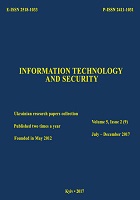Methods of statistical tests independence verification
DOI:
https://doi.org/10.20535/2411-1031.2017.5.2.136941Keywords:
Pseudorandom sequences generator, pseudorandom sequence, pseudorandom sequence quality, statistic tests of pseudorandom sequence quality assessment, test independence.Abstract
The necessary condition for the cryptosystem security is the certain cryptographic properties of pseudorandom number generator used in it. Therefore, both the developer and the user of such system are faced with the quality checking issues of the generator or its individual sequences. The main modern methods for pseudorandom sequence quality testing are reduced to the statistical randomness tests use. At the moment there are several statistical test suites, among which the most widely used is NIST statistical randomness test suite. The statistical tests choice and the suite creation is a complex task, since the tests should not only verify propinquity of pseudorandom sequence to true random sequence, but also perform such task effectively. Unfortunately, a compromise is achieved quite hard in this case and modern suites also have statistical dependencies, which unreasonably increase such suites operating time. Thus, one of the main question of tests suite construction and the statistical tests using is statistical independence of tests from this suite. To create an effective suite, tests without statistical dependencies should be used and, at the same time, the tests set should remain sufficiently complete. However, modern questions of forming texts suite, its number determination, type I error value, etc. are solved intuitively and empirically. This article provides the existing evaluation methods overview of statistical randomness tests independence verification and proposes a new, mathematically grounded method, which can be applied to arbitrary tests number and arbitrary random sequences number. The proposed method has advantages in speed and implementation. The paper also presents the experimental research results of the new method application to the statistical randomness test suite.
References
A.L. Kostevich, and A.V. Shilkin, “Analysis of tests for randomness based on universal predictors: Bernoulli trials case”, in Proc. 9th International conference Computer data analysis and modeling: complex stochastic data and systems, Minsk, 2010, pp. 36-39.
A. Doğanaksoy, F. Sulak, M. Uğuz, O. Şeker, and Z. Akcengiz “Mutual correlation of NIST statistical randomness tests and comparison of their sensitivities on transformed sequences”, Turkish Journal of Electrical Engineering and Computer Sciences, № 25 (2), pp. 655-665, 2017.
doi: 10.3906/elk-1503-214.
F. Sulak, M. Uğuz, O. Kocak, and A. Doğanaksoy “On the independence of statistical randomness tests included in the NIST test suite”, Turkish Journal of Electrical Engineering and Computer Sciences, № 25, pp. 3673-3683, 2017.
doi: 10.3906/elk-1605-212.
National Institute of Standards and Technology. (2010, April 27). NIST 800-22, A Statistical Test Suite for Random and Pseudorandom Number Generators for Cryptographic Applications. [Online]. Available: https://www.ipa.go.jp/files/000011794.pdf Accessed on: Sept. 25, 2017.
National Institute of Standards and Technology. (2010, August 11). NIST 800-22, Rev. 1a,
A Statistical Test Suite for Random and Pseudorandom Number Generators for Cryptographic Applications. [Online]. Available: https://www.ipa.go.jp/files/000011794.pdf Accessed on: Sept. 25, 2017.
L. Kovalchuk, and V. Bezditnyi, “Inspection of statistical tests independence intended for PRNG cryptographic qualities evaluation”, Ukrainian Information Security Research Journal, № 2 (29), pp. 18-23, 2006.
L. Kovalchuk, V. Bezditnyi, and L. Skrypnyk, “The method of statistical tests independence checking for sequence generator unknown statistical properties”, Legal, normative and metrological provision of the information security system in Ukraine, № 4 (21), pp. 35-41, 2010.
L. Skrypnik, L. Kovalchuk, and V. Bezditnyi, “Method of statistical tests independence checking”, in Proc. 9th International conference Computer data analysis and modeling: complex stochastic data and systems, Minsk, 2010, c. 71-74.
Governmental Standard of Ukraine. (2002, Dec. 28). GSTU 4145, Information technology. Cryptographic information protection. Elliptic curves digital signature. Formation and verification. Kyiv, 2003, 40 p.
T. Anderson, Introduction to Multidimensional Statistical Analysis. Moskow, Russia: Fizmatgiz, 1963.
Downloads
Published
How to Cite
Issue
Section
License
Copyright (c) 2020 Collection "Information technology and security"

This work is licensed under a Creative Commons Attribution 4.0 International License.
The authors that are published in this collection, agree to the following terms:
- The authors reserve the right to authorship of their work and pass the collection right of first publication this work is licensed under the Creative Commons Attribution License, which allows others to freely distribute the published work with the obligatory reference to the authors of the original work and the first publication of the work in this collection.
- The authors have the right to conclude an agreement on exclusive distribution of the work in the form in which it was published this anthology (for example, to place the work in a digital repository institution or to publish in the structure of the monograph), provided that references to the first publication of the work in this collection.
- Policy of the journal allows and encourages the placement of authors on the Internet (for example, in storage facilities or on personal web sites) the manuscript of the work, prior to the submission of the manuscript to the editor, and during its editorial processing, as it contributes to productive scientific discussion and positive effect on the efficiency and dynamics of citations of published work (see The Effect of Open Access).

